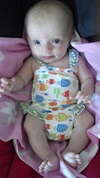 Avery Masters, 11, is like many other middle schoolers: she loves reading, singing, swimming and participating in her school’s theater club.
Avery Masters, 11, is like many other middle schoolers: she loves reading, singing, swimming and participating in her school’s theater club.
“Avery is a bright light to everyone around her,” says her mom, Janelle. “She’s spunky, sassy and a really sweet girl.”
But unlike her classmates, Avery lives with osteogenesis imperfecta, also known as “brittle bone disease,” a rare condition that makes her prone to frequent fractures.
A diagnosis from birth
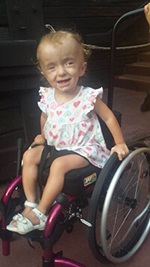 Avery was diagnosed with the condition shortly after she was born. Just before delivery, an ultrasound revealed that her left femur — the large bones in her upper thighs — was already fractured.
Avery was diagnosed with the condition shortly after she was born. Just before delivery, an ultrasound revealed that her left femur — the large bones in her upper thighs — was already fractured.
“They had to do a big C-section,” says Janelle. “They didn’t want her to break any more bones.”
Once she was delivered, imaging revealed healing rib fractures as well. Genetic testing confirmed the diagnosis: type III osteogenesis imperfecta, the second-most severe form of the disease.
Children with osteogenesis imperfecta can face a range of difficult symptoms. Their bones can fracture easily, sometimes with little or no impact. Many experience chronic pain, muscle weakness and a curved spine. Some have a distinct facial shape, brittle teeth or bruise more easily than others. Breathing and hearing can also be affected, adding to the daily challenges they and their families must navigate.
Living with fragile bones
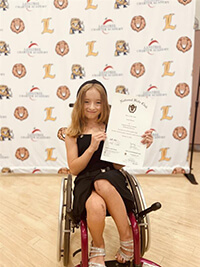
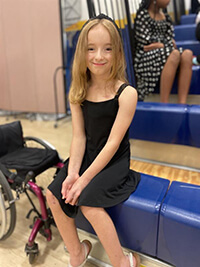 “Avery has sustained multiple fractures over the years,” says Dr. Brian Scannell, the medical director of the orthopedics program at Atrium Health Levine Children’s Hospital, named a ‘Best Children's Hospital’ for pediatric orthopedics by U.S. News & World Report. “She has also had multiple surgeries because of these fractures and bone deformities.”
“Avery has sustained multiple fractures over the years,” says Dr. Brian Scannell, the medical director of the orthopedics program at Atrium Health Levine Children’s Hospital, named a ‘Best Children's Hospital’ for pediatric orthopedics by U.S. News & World Report. “She has also had multiple surgeries because of these fractures and bone deformities.”
Everyday life carries risks. Recently, Avery broke both her legs after tripping over a pair of headphones at home, fracturing her shinbone in one leg and her thigh bone in the other. Another time, she was simply running and playing when she twisted her knee and fractured her femur.
Currently, Avery is under the care of the Levine Children’s team, receiving regular infusions to help strengthen her bones. She has undergone eight orthopedic surgeries and three non-orthopedic surgeries. She’s also had caps placed on her teeth, and because of hearing loss in her left ear, she now uses a hearing aid.
Treatment and hope for the future
Treatment options for osteogenesis imperfecta focus on preventing broken bones and deformities. Treatments can include:
- Bisphosphonate intravenous (IV) medication to strengthen the bones.
- Bracing, casting and splinting to treat fractures without surgery.
- Surgery, such as repairing broken bones or placing metal rods to stabilize long bones.
- Physical and occupational therapy.
- Assistive devices like custom equipment and wheelchairs as needed.
- Dental procedures, like capping, surgery and braces.
“I am hopeful for new medical treatments in the future,” says Dr. Scannell. “New treatment approaches for osteogenesis imperfecta include setrusumab, an antibody that increases bone formation. It has received ‘Breakthrough Therapy’ designation from the FDA for osteogenesis imperfecta types I, III and IV. However, this is still in early trials. I suspect that medical management will continue to improve, which will hopefully also help surgical outcomes. At Levine Children’s, we’re not just watching these developments — we're working to bring the most promising care to our patients so more kids like Avery can thrive.”
Emotional strength and support
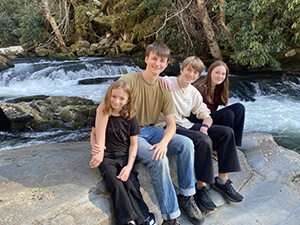 Living with a chronic condition has been challenging for Avery, but her resilience shines through.
Living with a chronic condition has been challenging for Avery, but her resilience shines through.
“The condition does take a toll on her mentally,” says Janelle. “She knows there will always be another break, another surgery ahead. It can be discouraging knowing that she can’t run and play with her friends during PE.”
To cope, Avery sees a counselor and writes in her journal regularly. She loves to swim and hopes to join a swim team someday. Her school has also made adjustments to support her, such as providing two sets of books (one to keep at school and one to keep at home) so she can carry a lighter backpack.
Surrounded by the love of her family, community and care team at Levine Children’s, Avery is growing into someone whose light touches everyone she meets.
“Avery is an amazing kid,” says Janelle. “We have a strong faith and it’s helped us through a lot. She has been a blessing.”



